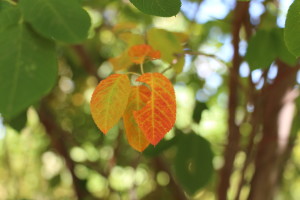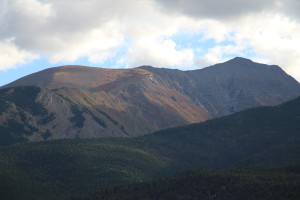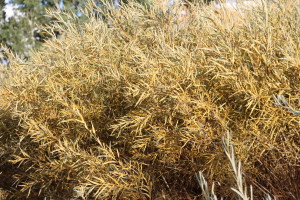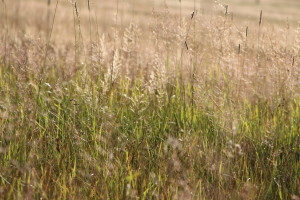The End of Summer
Caretaker Patty Reagin writes a monthly blog on the flora and fauna of the Wet Mountain Valley called “Spotted” for San Isabel Land Protection Trust (SILPT), the non-profit that holds the conservation easement for Humboldt Peak Ranch. This post is re-posted here courtesy of SILPT.
Last weekend was Labor Day weekend – unofficial end to the summer. While the valley is still lush, green, and warm, hints of fall are beginning to nudge away the lazy summer days. We recently moved residences, and looking out our new window at a bush I saw one lone branch sporting leaves that had turned crimson red. A few days ago I rode the horses past a willow stand that was golden, and any as-yet-uncut hay fields left in the Valley wave in the late summer breeze with shades of rust, orange, yellow, and bronze sprinkled amid the green.

September is a month of vast change. The autumnal equinox won’t occur for a few weeks yet, but in the high country fall has already begun. The tundra on the peaks has started to change from deep emerald to rust and gold and it won’t be long before snow starts to fly again in these high places. Very soon an early-changing stand of aspen or oak on the flanks of the Sangres will catch our eye,  suddenly bright gold against the homogenous green of the surrounding forest.
suddenly bright gold against the homogenous green of the surrounding forest.
We haven’t heard the distinctive sound of the nighthawks flying over the meadows for a few days now. Nighthawks are one of the very earliest of the migrating birds, and are presumably well on their way back to Mexico or South America – soon to be followed by the tiny hummingbirds who are still drinking their fill at feeders across the Valley. Geese have been flying over in formation, on their way elsewhere, and we heard the rattling call of a group of sandhill cranes in the dark wee hours a few mornings ago. Mule deer bucks and bull elk are in full antler again – muscled, primed and ready to fight when the rut begins.
Monsoon season has been winding down with only a few sprinkles here and there in the afternoons.  Ditches are dry, and creeks are down to a mellow babble. The late afternoon angle of the sun has just begun to produce that certain lush quality of light that occurs only in autumn, and will soon be lighting up the changing aspen, willow, oak, and cottonwood with a breathtaking fiery glow.
Ditches are dry, and creeks are down to a mellow babble. The late afternoon angle of the sun has just begun to produce that certain lush quality of light that occurs only in autumn, and will soon be lighting up the changing aspen, willow, oak, and cottonwood with a breathtaking fiery glow.
On the human side of things, harvest is in full swing with an abundance of Palisade peaches and Olathe sweet corn and Rocky Ford melons. Zucchini appear mysteriously on neighbor’s porches and canning fever has begun as gardens produce prolifically before the first frost marks the end of the growing season. Vast acres of Valley floor hay fields are in varying stages of being cut, some with neat rows of loose hay drying in the warm sun, some with bales of all sizes ready to be hauled to local barns or Front Range buyers. Tourists try to fit in one last vacation, one last weekend, one last camping trip, and orange hats and vests have been sighted as archery season starts off the round of fall hunting.

Here in our new home we’re busy too. We’re harvesting chokecherries alongside robins and magpies, gleaning the last of the tomatoes, squash, and melons from our own garden and putting up some of the bounty for winter use. Beautiful local hay bales are stacked in the barn, fragrant and ready for our horses to eat during the long snowy winter ahead.
The days are still so warm it’s easy to forget the exuberance of summer is winding down and the introspective winter season is almost upon us. From inside the frenzy of summer fun and harvest time, it’s almost a relief to think about cozy, quiet afternoons in front of the wood stove. But we’re not there yet. In the meantime we’ll glean every last bit of warmth from the sun, and look forward to that most glorious of seasons in the Colorado high country – Fall.